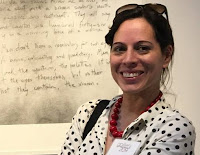Sandra talks about todo, about personas, sentimientos,
emociones, artistas, culturas, países. Así como habla, crea. Crea plantas y
animales “lunáticos”, juguetones y de colores vibrantes. Y piensa sobre la
falta de tiempo para crear cuando se tiene una familia grande. “Y me da pena
que otras profesiones "sublimes" (como los médicos sanan, los
abogados luchan por justicia) son carreras reconocidas y remuneradas... pero el
arte no”, dice.
Sandra Pérez Ramos Inventa gatos, pájaros, arboles y corazones,
entre otras cosas, y los hace interesantes a la vista y a la imaginación. Cría
tres hijos, dos niñas que aun están en la primaria y un hijo que ya casi es un
adulto. Y realiza trabajo voluntario
para organizaciones de artistas (TLAL, WAP, MAA, Gallery 209),, una "labor muy intensa y a la vez súper personally fulfilling”, asegura.
Salir a caminar con su familia y terminar tomando fotos de los hongos
aparecidos después de la lluvia no es cosa rara en su vida. “Inspiración viene de TODO. La naturaleza y sus rarezas
me encanta. Me parece ridículo llamarse artista y estar aislado, o no estar al
tanto, estar sin conmoverse de todas las otras corrientes creativas
(arquitectura, diseño industrial, artes decorativas, cerámica, madera, danza,
diseño gráfico, diseño de interiores, moda, música)”, enfatiza.
Sandra
lee, y busca constantemente objetos y antigüedades. La inspiran los textiles y arte folclórico a
nivel global (Mexico, Peru, Guatemala, Africa, Uzbekistán, Escandinavia), el
naive, primitivismo, el modernismo de los 50's. “Yo creo es necesario como artista ser "all
encompassing". Trato de mantenerme rodeada de esas cosas raras e
interesantes. Aprendí de un artista profesor que ‘el artista lleva la estética
a todo’. Todo lo que hacemos y nuestro ambiente debe integrar la estética. No
ser artista de canvas los domingos y vivir sin pasiones, sin gusto. Hay que
lograrla, vivir la estética en TODA FACETA”.
Llego a los
Estados Unidos en el 2005 y sobre el arte en su país de origen remarca, “En
Puerto Rico la corriente contemporánea o lo que se valora como arte
"serio" es siempre intenso, político o social y tengo algunos
momentos de esa búsqueda, pero siempre raya en introspectivo. Pero en mis
ilustraciones, que comenzaron como un ejercicio para salir del bloqueo
creativo... permito que salga ‘la niña’, el realismo mágico tan típico latino,
o esa mezcla que se da en el Caribe donde hay sincretismo... superstición y
realidad de la mano, jugando, conviviendo y enredando a la cultura”.
Y lo que resume
su vida es lo mismo que piensa sobre el arte: “El arte está en todo. El proceso
creativo (ojo-mente-mano) permite la canalización de energías, sana,
tranquiliza. Es sublime. Nos pone en contacto con lo interno y nos hace
"Aware" del resto, de todo lo que nos rodea y de nuestra conexión con
todo, todo. Aun la destrucción conlleva a la re-creación. No hay más ná... no
concibo la idea de una vida sin arte. No es posible”.
Su madre la puso
en su primera clase de arte a los 7 años, su padre le regaló su primera cámara
fotográfica y desde entonces no ha dejado de retratar el cielo. Las iniciales
de su apellido son PR, igual lo son las de la isla desde donde se ha traído los
colores.
Mire este vídeo para conocer más sobre las obras de arte de Sandra:

















